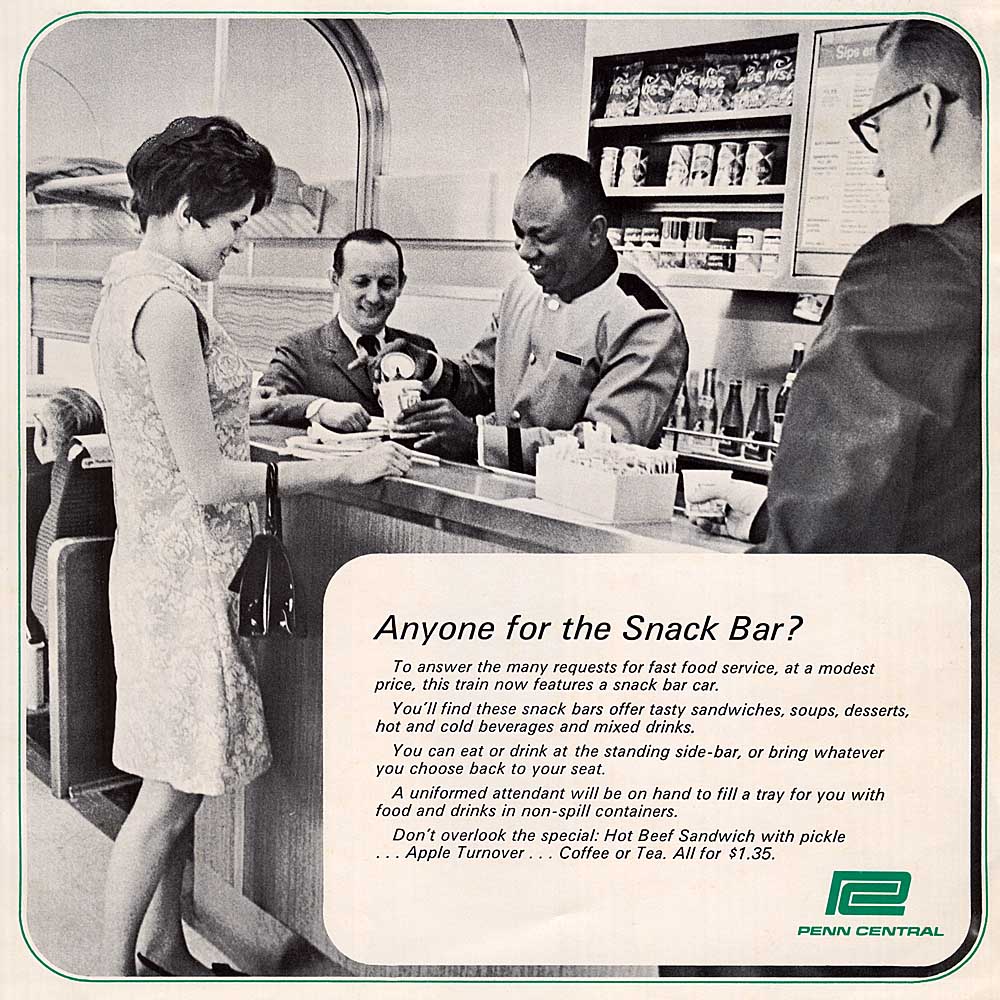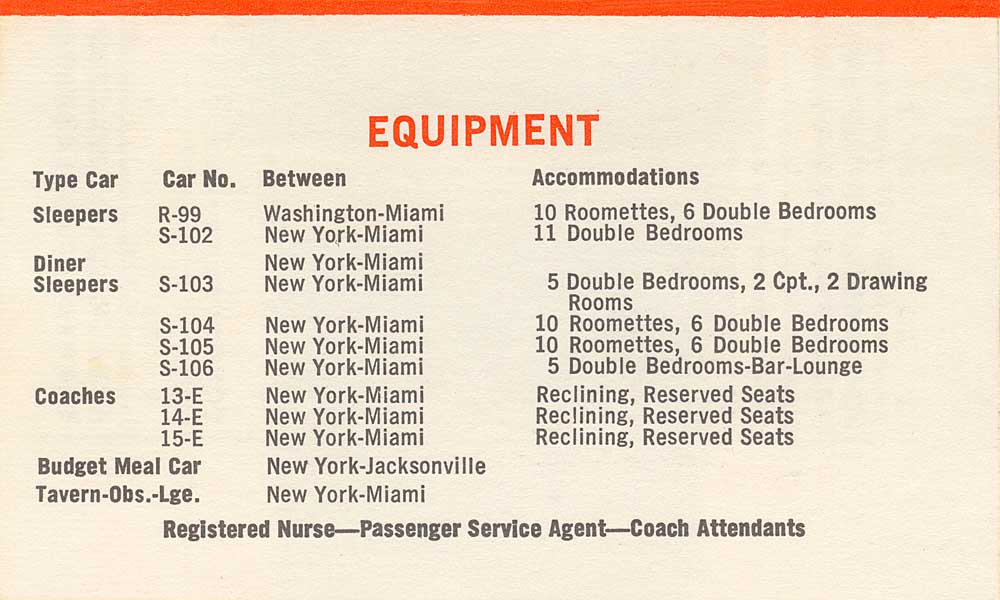
In the past, railroad dining car meals were something to write home about, positively. A notable summary of this can be found in the lyrics of the popular song Chattanooga Choo-Choo, with its assertion that “dinner in the diner, nothing could be finer.”
As private-railroad passenger service declined in the 1960s, however, this became a proposition that was increasingly difficult to sustain. Prior to World War II, virtually all intercity business travel had utilized rail travel, including first-class sleeping car accommodations when overnight journeys were involved. The expense account traveler was used to having nice meals in hotels and expected similar quality during their journeys on the rails.
Postwar, airline service expanded rapidly, migrating many business travelers to that mode, particularly for long-distance trips. In addition, this also enabled many to desert the once-ubiquitous overnight sleepers on medium and short-haul routes in favor of “same day” trips that departed in the morning and returned in the evening and required no overnights away from home.
Rail coach traffic did not fall off as rapidly, but in many cases, these passengers either didn’t want, or more likely, couldn’t afford, formal restaurant-style meals while enroute. Thus, the already difficult economics of dining cars, which were almost universally deemed to be unprofitable, got even worse as sleeping and parlor car patronage declined in the 1950s.
In addition, societal customs began to undergo changes, often in favor of less formal, and often more inexpensive alternatives with respect to nourishment; “Fast food” began to become popular. Previously, even highway travelers tended to stop at sit-down restaurants, either local cafes, or chains like Howard Johnsons that had sprung up to cater to this market.
By the 1960s, chain fast-food enterprises such as McDonalds were springing up all over the national landscape for both local usage and catering to highway travelers. This trend continued to accelerate, with the result that in most areas of any population, fast-food is not difficult to find, while today’s traveler will search in vain trying to locate any Howard Johnson restaurants.
To some extent railroads did offer multiple levels of food service, particularly on long-haul trains. Full dining facilities were provided for sleeping car passengers, while other less formal (and less costly) alternatives were offered for coach travelers; think the North Coast Limited’s “Travelers Rest” cars, for example.
Trending away from railroad dining car meals
When the Pennsylvania and New Haven railroads launched their Budd-built Congressional and Senator equipment in 1952 in what is now referred to as the “Northeast Corridor,” both sets included a “Lunch Counter Tavern Lounge” car in addition to the regular dining cars (twin-unit on the Congo, and a conventional/single-unit for the Senator) that catered primarily to the Parlor Car passengers, an indication that even then there was a portion of this market that preferred something less than a full meal.
In 1965, even the modestly sized C&EI (Chicago and Eastern Illinois) joined this trend, by converting a former tavern lounge (that had originally been a coach of C&O’s stillborn Chessie daytime streamliner) to a lunch-counter lounge named the “Harvest Inn” for the road’s Danville Flyer.
The single-page card menu for this innovation listed “Hot and Cold Drinks” and “Beverages” (the latter implying alcoholic), as well as the food service, offered under the trendy term “Eatables,” that included a variety of sandwiches (no mention of any at other than room temperature) along with sweet rolls and buttered toast. No individual item cost more than $1.25. While this apparently was sufficient to stave off starvation between Chicago and downstate Illinois, it may not be a coincidence that longtime dining-car partisan Lucius Beebe died the next year.
Future merger partner Louisville & Nashville acquired the C&EI’s two former Maine Central dining-parlor cars in 1959, and in 1965 converted them to lunch counter-lounges for what remained of the L&N’s flagship Pan American. By 1969, even the relatively pro-passenger Seaboard Coast Line had converted one of the two single-unit diners on its New York-Miami Silver Meteor to what it termed a “Budget Meal Car” that ran as far south as Jacksonville.

A harbinger of more widespread change along these lines can be seen in the Pennsylvania’s Form 1 System Timetable of April 4, 1965, which showed “Sandwiches-Snacks-Beverages available at your seat” for many trains in the New York-Washington market. This type of service harkened back to the days of “news butches” selling such items to an earlier generation of travelers; coincidentally, this also was the way airlines served their passengers.
A year later, the Pennsy’s April 2, 1965, timetable indicated that a “Snack Bar Coach – Hot-Cold Food and Beverages” had supplanted the “at your seat” offerings of the previous year. This type of car also provided the only food and beverage service on the Harrisburg-Washington portion of the General’s route; the likely few remaining sleeper patrons on what had been the Liberty Limited probably were somewhat taken aback at their dining ‘options’ south of the Pennsylvania state capital.
During the mid-1960s, the Pennsy converted several postwar sleeping cars into coaches for use in the Corridor; a modest number of these became snack bar coaches in the process to provide this service. They also served as a replacement for the lunch counter lounges on the Congressionals.
In December 1967, the New York Central converted most of its service within New York State to the “Empire Service” operating model, which did away with conventional dining services on these trains. After initial service using some of the NYC’s fleet of tavern and parlor buffet lounges (the latter typically being former 6 Bedroom lounges), the road elected to convert several of its 3000-series Pullman-Standard fluted-side coaches into what they termed “chair buffet cars.”
By now, it was clear that the die had been cast, and that starched linen, formal glassware and cutlery had little future in U.S. railroad intercity passenger service. When the Metroliners went into service, they offered at-your-seat service to premium passengers, and a stand-up snack car for the (relative) plebians. Closing the book of the trends that we’ve been examining, Amtrak’s first major passenger car acquisition, in the form of the Amfleet cars, followed the same pattern when it arrived in 1975.














As noted in the article many people today prefer a fast food type of menus for food service today. As long as Amtrak today provides a good choice of hot and cold sandwiches and maybe limited other hot food it will satisfy most passengers especially on shorter time regional trains. However on long distance trains I feel they still should offer at least a good selection of food that sit down resturants would offer travelers. They also should allow coach passengers access to sit down dining car service. On long distance trains since they are all reserved there is no reason a passenger could not choose to reserve a meal and pay in advance for a meal in the dinner. I will give a good example where they are loosing dining car revenue. I have taken many trips between Philadelphia, Pa and Minneapolis, Mn. While I use a sleeper between Phila. And Chicago. I use a coach seat on the Empire Builder between Chicago and Minneapolis and in the past have always enjoyed dinner in the dinner on my way to Minneapolis. Now I have only the lounge car for dinner. So on my last trip to Minnapolis I only took the regional train to Milwaukee and rented a car for the rest of my trip. Amtrak lost both the additional rail fare plus the money I would have spent in the dinner.